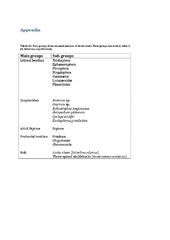Blar i forfatter "Skoglund, Sigrid Østrem"
-
Effects of water level regulation in alpine hydropower reservoirs: an ecosystem perspective with a special emphasis on fish
Hirsch, Philipp E.; Eloranta, Antti; Amundsen, Per-Arne; Brabrand, Åge; Charmasson, Julie; Helland, Ingeborg Palm; Power, Michael John; Sanchez-Hernandez, Javier; Sandlund, Odd Terje; Sauterleute, Julian Friedrich; Skoglund, Sigrid Østrem; Ugedal, Ola; Yang, Hong (Journal article; Tidsskriftartikkel; Peer reviewed, 2017-02-04)Sustainable development of hydropower demands a holistic view of potential impacts of water level regulation (WLR) on reservoir ecosystems. Most environmental studies of hydropower have focused on rivers, whereas environmental effects of hydropower operations on reservoirs are less well understood. Here, we synthesize knowledge on how WLR from hydropower affects alpine lake ecosystems and highlight ... -
Morphological divergence between three Arctic charr morphs - the significance of the deep-water environment.
Skoglund, Sigrid Østrem; Siwertsson, Anna; Knudsen, Rune; Amundsen, Per-Arne (Journal article; Tidsskriftartikkel; Peer reviewed, 2015-07-14)Morphological divergence was evident among three sympatric morphs of Arctic charr (Salvelinus alpinus (L.)) that are ecologically diverged along the shallow-, deep-water resource axis in a subarctic postglacial lake (Norway). The two deep-water (profundal) spawning morphs, a benthivore (PB-morph) and a piscivore (PP-morph), have evolved under identical abiotic conditions with constant low light ... -
Morphological divergence in a trimorphic population of Arctic charr (Salvelinus alpinus (L.)) in Skogsfjordvatn, northern Norway.
Skoglund, Sigrid Østrem (Master thesis; Mastergradsoppgave, 2013-09-30)Sympatric polymorphisms are found in many freshwater fish taxa, including the salmonid Arctic charr (Salvelinus alpinus (L.)). Polymorphism is often expressed as differences in morphology, behaviour and life-history strategies, and may be driven by alternative phenotypic adaptations to resource use such as habitat and prey preferences. Morphological divergence is usually linked to different functions ...


 English
English norsk
norsk

